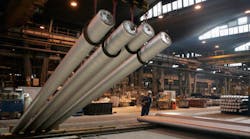Alcoa Inc. cut projections for its largest manufacturing unit as the biggest U.S. aluminum producer prepares to split itself in two amid slumping profit.
The New York-based company is contending with lower prices and margins as Chinese demand for commodities slows and one of its main customers, Boeing Co., halves production of its biggest jet.
Alcoa is under “enormous pressure” from aircraft manufacturers, CEO Klaus Kleinfeld said Monday on a call with analysts to discuss first-quarter results. “And they are under pressure from their customers. We will have to continue to win through innovation.”
Engineered Products and Services, which will be the largest segment of the new downstream company to be called Arconic, will generate sales of as low as $6 billion this year, compared with an earlier forecast for $7 billion, as margins tighten. Smelting and refining operations will form a separate company that will retain the Alcoa banner, under a plan revealed in September.
“There will be some disappointment” on the outlook for engineered products, said Anthony Young, an analyst at Macquarie Group Ltd. “This is the cornerstone of Arconic and if that business isn’t as good as they previously thought, it may negatively impact the longer-term valuation.”
First-quarter net income fell 92% to $16 million as operating profit plunged in the units that make alumina and primary metals, it said in a statement. Total sales sank more than estimated to $4.95 billion as average prices dropped 16% on-year. The stock has lost 26% in the past year, in line with the Bloomberg World Mining Index’s decline. A gauge of manufacturing shares is down just 4% in the same span.
The portion of Alcoa’s revenue that comes from selling the primary metal and its precursor alumina has dropped to 40% as prices have tumbled and Kleinfeld has shut down and sold off smelting capacity.
Meanwhile, he has bolstered segments that shape and form the metal by expanding automotive-product capacity, retooling existing factories and buying companies such as aerospace supplier Firth Rixson Ltd. Alcoa’s key customers in aircraft production and automotive manufacturing have seen record production, while vehicle lightweighting has boosted the amount of aluminum in cars and trucks in North America.
Alcoa lowered its forecast for global consumption of the metal this year and decreased its market deficit projection as Chinese demand growth slows. In aerospace, Alcoa is projecting 6% to 8% global aerospace sales growth in 2016, revised from the 8% to 9% estimated in January.
Alcoa cut 600 jobs in the engineered products and solutions unit in the first quarter, and plans a further reduction of 400. Additionally, given the current market environment, it is evaluating another reduction of as many as 1,000 positions, the company said.
“Aluminum, while still being a metal where you have pretty attractive growth markets, that’s been pared back a little bit,” Macquarie’s Young said. “A portion of that’s China and a portion of that is other cross currents.”
By Sonja Elmquist



